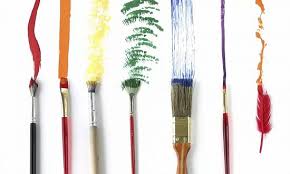MASTERPIECES OF PASTEL FROM FUNDS OF THE TREYAKOV GALLERY (part 1)
 The collection of the State Tretyakov Gallery contains about 800 pastels, some were purchased by P.M. Tretyakov.
The collection of the State Tretyakov Gallery contains about 800 pastels, some were purchased by P.M. Tretyakov.
Pastel must be stored under glass. It is very vulnerable: it can fall off from a concussion, all kinds of travels are dangerous for it, it is disastrously affected by direct sunlight, temperature extremes, excessive dryness or humidity. Constant concern for the safety of “loose” pastel works does not allow them to be often and continuously exposed. To see them in the halls of the museum is a rare and significant event.
The word pastel comes from Italian pasta – pasta or pastry. This is the name of the material for drawing, the technique in which the artist works, and, finally, the artwork drawn with pastel pencils.
The pastel is colored crayons, pressed in the form of sticks from a finely ground mixture, which included three ingredients: a coloring pigment, a mineral filler (chalk or a special type of clay) and a binder (in most cases, gum arabic). The pastel has more than one thousand six hundred and fifty shades.
The pastel appeared in artistic practice at the end of the 15th century. The rarest example of its use is in the sketch of Leonardo da Vinci for a portrait of Isabella d’Este Mantua (1495), executed in black chalk, sanguine and pastel in several places for easy shading of the black pattern. Leonardo calls the new technique colorire a secco (dry-stained) and identifies it with pastel. According to the artist, with this technique he was introduced to the French poet and court painter Louis XII – Jean Perreal.
At the beginning of the XVI century, pastel took a strong place in art practice. Let us recall the French pencil portrait that arose at that time, a special type of bust portrait à troi crayons (in three pencils – with black chalk, sanguine and pastel), performed from nature in one or two sessions. In Italian, this combination of drawing materials was called a pastello. For several centuries, such drawing techniques, leading to the very beginnings of pastel technology, have been stably preserved.
Loose pastel does not hold well on the surface, so it requires a special rough base. Chopsticks work on special grades of paper, such as torshon, emery, on loose, fleecy cardboard, suede, parchment, canvas. Diverse and methods of work. Pastel touches are rubbed with fingers, a palm, special feathering (from elderberry core), leather rollers, silk square brush brushes, soft tampons. Pastel combines the possibilities of painting and drawing. She can draw and write, work with hatching or a painting spot, with a dry and wet brush.
The pastel technique gained wide popularity and reached its peak in the 18th century. However, artists were constantly worried about the problem of the safety of works, which became the topic of many scholarly treatises. Various fixatives were invented, but even the most advanced of them changed the tone of the pastel, distorted its original color scheme, ruined its natural velvetiness and fluffiness.
Even D. Didro expressed to the famous pastelist M.K. de Laturu, his fears that the flapping of the wings of time will leave nothing from the glory of the great master and the precious dust will disappear from the surface, and part of it will dissipate in the air. Fortunately, his fears did not materialize. The pastel turned out to be quite hardy. This is confirmed by ancient pastels stored in museums in Europe, still surprising with the freshness of their colors, like the famous “Chocolate Girl” by J.E. Liotard from the Dresden Gallery.
In pastel portraits of the 18th century there is always a nagging note, a smack of primordial doom, precisely because of the fragility of the technique itself – delicate as pollen on the wings of a butterfly and just as short-lived and disappearing with careless touch. Easily decaying pastel visually embodies the idea of the mortality of human existence. It is no coincidence that A.R. Mengs, a German artist and theorist of art of the 18th century, compared pastels to “butterflies in the flower garden of art”.




